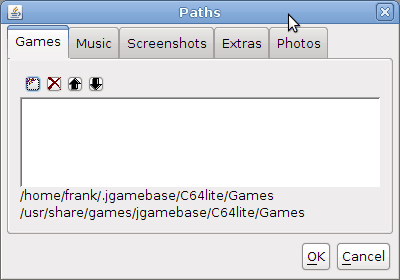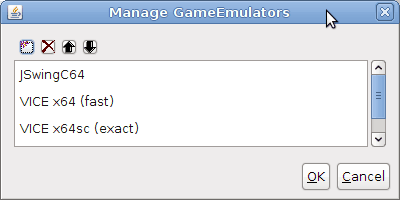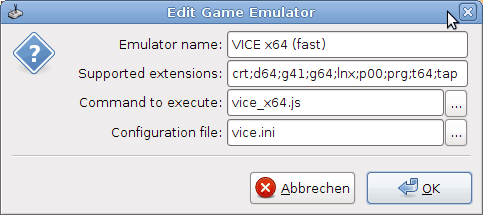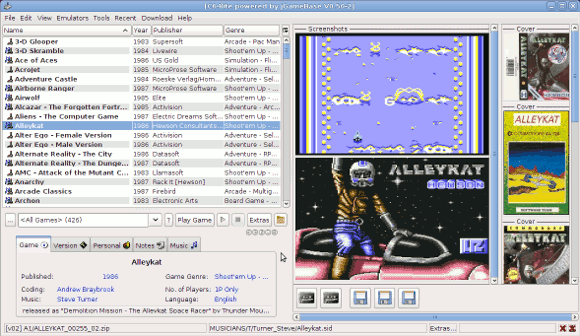jGameBase Manual
1. Starting jGameBase
1.1 On Linux™/UNIX™ or Apple Macintosh™
On Linux™/UNIX™ or Apple Macintosh™ simply start the "jgamebase.sh".
1.2 On Microsoft Windows™
On MS Windows™ simply start the "jgamebase.bat".
There is a native frontend GameBase (without "j") for MS Windows™ - perhaps you want to try it.1.3 On other operating systems
On other operating systems you have to start jGameBase by calling Java
directly via
"java -jar jgamebase.jar".
2. First Steps
2.1 Sample Database
jGameBase includes a small demo database of C64 classics "C64lite" containing screenshots (from GameBase64) and music files (from High Voltage SID Collection).For copyright reasons there are no games or extra files (game reviews, etc.) included.
2.2 Installing a Database
- Download a game database e.g. GameBase64
or GameBase Amiga
(there is a list of jGameBase projects on the GameBase64 Forum).
- Extract the files to a subdirectory in the database directory. On
Linux this is "~/.jgamebase", on MS Windows it is the jGameBase
directory. During application start jGameBase prints the
location of the database directory to the console and to the log file.
Unfortunately some databases are only available as MS Windows installer; you can try to extract them using WINE.
- Download additional files (screenshots, music, etc.). If possible
put them in the default directories "Games", "Screenshots", "Extras",
"Music", and "Photos".
- Start jGameBase (not imported Access databases will be
automatically discovered).
- If necessary configure the paths to the downloaded files (Menu
"Tools → Paths...").
Files in the directories "Games", "Screenshots", "Extras", "Music", and "Photos" will be found without specifying a path.

Double click
Edit

New

Remove

Up in search order

Down in search order
- Now it is necessary to update the status of the files by verifying
that the files can be found. This search is done case independent and files with wrong case will be corrected automatically. (Menu "Tools → Verify Available
Files...").
Select the type of files you want to check and click "Start"To know what files you are missing check the file "VerifyAvailableFiles.log" and the missing files lists (*.mfl) that were created in the database directory.
- Configure the emulators (Menu "Emulators").

Double click
Edit

New

Remove

Up in search order

Down in search order

Emulator name
The name displayed for this emulator
Supported extensions
A list of file extensions this emulator can handle, separated by semicolons. The use of "*" as wildcard is discouraged, because this emulator would be called for all files.
Command to execute
The command to start the emulator. If no path is given the file is expected to be in the current databases script directory "Scripts".
Configuration file
The configuration file for this emulator. The emulator command (s. above) can modify this file prior to starting the emulator.
3. Using jGameBase

3.1 Identifying Games and Music
Although it's name suggests that only games are supported, jGameBase
also supports music. Due to the fact that many computer emulated music
belongs to games but many does not (e.g. demo or intro music), jGameBase
manages items in two main tables. Firstly there is a Games
table, where all games and their respective info is stored (including the
information which game and music files belong to this game). Secondly
there is a Music table, where
all pieces of music that do not belong to a game are stored.
In jGameBase you can view items from the Games and Music tables separately or together in the same list. Items in the list are identified by their icon:
| The item is a Game, and it has a game and a music file attached. | |
| The item is a Game, and it has only a game file attached. | |
| The item is a Game, and it has only a music file attached. | |
| The item is a piece of Music. | |
| no icon | The item is a Game, neither a game file nor a music file is attached. |
When you click on a Game item, the game's info will appear under the list of items in a tabbed display and any pictures will appear to the right of the list.
When you click on a Music item, the music's info will appear under the list of items and the music author's photo (if one exists) will appear to the right of the list.
3.2 The Panel

| "..." button |
View and Quickfilter Menu. Here you can modify views and set filters. |
| "View" list |
Selection list of available Views. |
| "?"
button |
Select a random item. |
| "Play Game" button |
Play the selected game. |
| "Play" button |
Play the selected piece of music. |
| "Stop" button | Stop the currently playing music. |
| "Extras" button |
Open extras for the selected game. |
| Folder button |
Open the folder for additional extras for the selected game. |
3.3 Playing Games
To play a game with the default emulator, left-click the "Play Game" button in the main jGameBase window. Right-clicking this button displays a list of available game emulators for you to choose from.3.4 Playing Music
To play a piece of music with the default music player, left-click the "‣" button in the main jGameBase window. Right-clicking this button displays a list of available music players for you to choose from.3.5 Running Extras
If there are Extras set up for the currently selected game, you can run them by clicking the "Extras" button in the main jGameBase window and selecting the desired Extra from the list.| Home | Mail Webmaster | ||
| Page last updated: 15. November 2022. |
